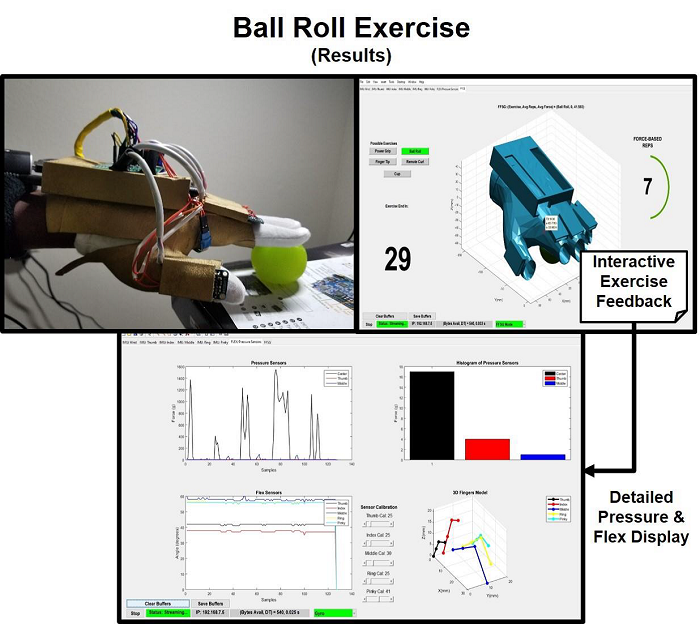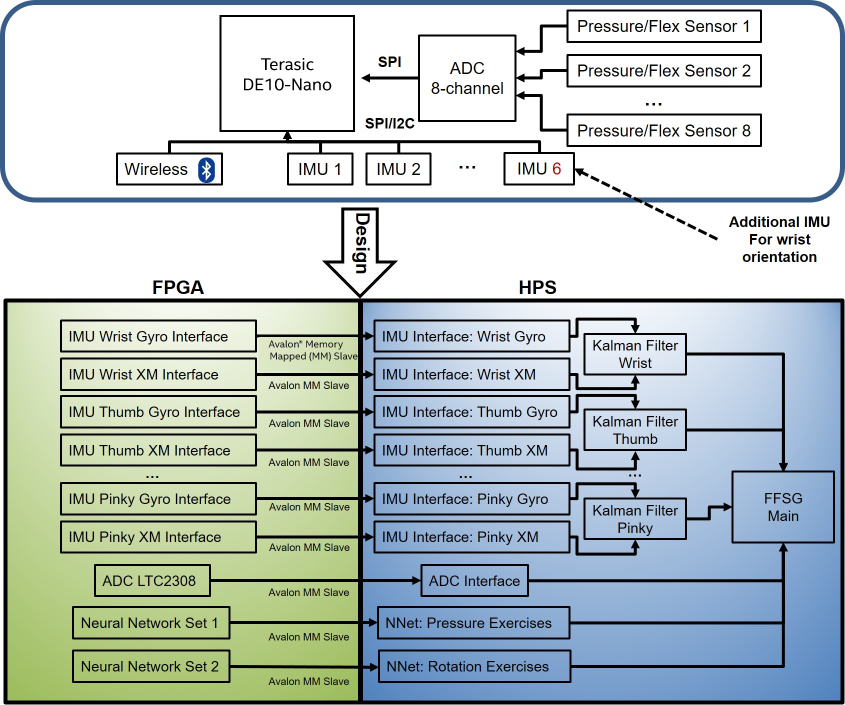Recovery from stroke injuries presents many challenges and sometimes offers minimal progress, despite regular physical therapy efforts to stimulate sensorimotor activities. A system to measure, record, and display therapy in the form of data creates a method for a patient to track progress in real time. The Flex Force Smart Glove (FFSG), powered by a Cyclone® V SoC FPGA on the Terasic DE10-Nano kit, enhances traditional therapy methods by analyzing the sensorimotor signals from the wrist and fingers of the human hand. With this solution, a therapist and patient can focus on sessions that are tailored to individual recovery goals.

Figure 1. Flex Force Smart Glove and Software
Hardware
- Terasic* DE10-Nano kit (Cyclone® V SoC FPGA and ARM* Cortex-A9 MPCore processor)
- Pressure and flex sensors
- Multi-channel analog-to-digital converter (ADC)
- Inertial Measurement Unit (IMU) sensors
- Bluetooth*
Software
- Intel® Quartus® Prime Software
- Trained neural network to recognize hand exercises (inference runs on the FPGA)
The smart glove receives data through various sensors and provides feedback with digital signal processing (DSP) capabilities, which include the implementation of finite infinite response (FIR) filters to remove out-of-band sampling noise from the pressure sensors. It also computes the kinematic features of the finger and hand movements, which require real-time integration of data from the five inertial measurement unit (IMU) sensors. The smart glove uses the combined data to compute the pitch, roll, and yaw of some of the hand exercises, which were accomplished by implementing six Kalman filters on the Intel® SoC FPGA. The solution uses Fugl-Meyer assessment scores, based on the sensorimotor data from the hand, to evaluate the patient’s physical performance. Figure 2 illustrates the solution design and architecture.

Figure 2. Design and Architecture of Flex Force Smart Glove
The Intel® SoC FPGA Advantage
The Intel SoC FPGA provides a high-performance solution, supporting smart glove technology in a physical therapy context. Its outstanding qualities include:
Performance Boost
The FPGA integrates data from various sensors and runs the inference of a trained neural network to classify compute-intensive hand exercises. The Cyclone V SoC FPGA improved the system performance, offloading workloads from the ARM* processor to the Cyclone V SoC FPGA.
Adaptability to Changes
The Cyclone V SoC FPGA provides the flexibility to program and analyze different movements of the hand and re-assess the input instantly, eliminating the need to reconfigure for each variation. Over time, the number and range of exercises the solution supports can grow.
I/O Expansion
Custom IP cores (sensor interfaces) enable the Cyclone V SoC FPGA to retrieve sensor data from the IMU sensors for processing. I/O Expansion can be leveraged to scale the application and incorporate other functionalities and exercise movements.
The Flex Force Smart Glove demonstrates the essence of employing an FPGA in the Age of Data. Application of the technology in the area of physical therapy serves as a perfect example of the power of analytics to enhance experience and transform lives. See a more in-depth breakdown of blocks, modules, and functions at the contest page Innovate FPGA.